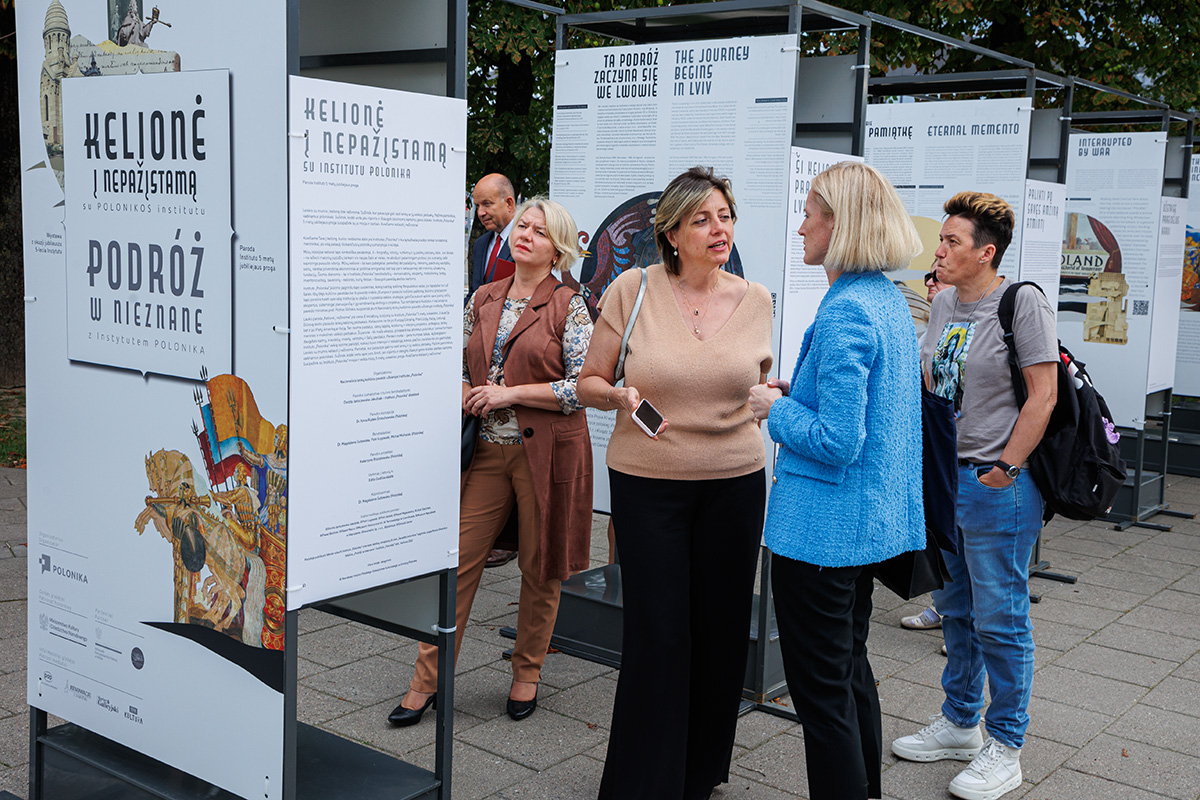- September 7, 2023
- 446
To make the unknown known: a unique exhibition at the House of Polish Culture in Vilnius

On Tuesday, the 5th of September, the exhibition “Journey into the unknown with the “Polonika” Institute” was presented for the first time at the House of Polish Culture in Vilnius.
“With this exhibition, we want to show how much Poland and other countries in the world have in common but also how much Poland and Lithuania have in common” said Konstanty Radziwił, Ambassador of Poland, during the vernissage in Vilnius.
Vilnius is by no coincidence the location of the exhibition, as in this city the “Polonika” Institute carries out many research and conservation projects, which are also described in the exhibition.
“The exhibition will take us on a fascinating journey through the richness and diversity of objects, which are the centre of the “Polonika” Institute’s activities in the field of conservation, scientific research, and popularisation of knowledge. This is a unique opportunity to enrich the cultural field for the citizens of Vilnius” ensured Bożena Mieżonis, coordinator of cultural projects at the House of Polish Culture in Vilnius during the opening of the exhibition.
“The “ Journey into the unknown exhibition” is another project that we as an embassy carry out in Lithuania together with the “Polonika” Institue. It is an excellent reflection of the effort and the important role that the “Polonika” Institue plays in preserving the material testimony of our history and promoting knowledge about the Polish heritage around the world” stated Konstanty Radziwiłł.
The Ambassador emphasized that “Polonika” Institute has been very active since the beginning of its existence. Thanks to the activities of the institute and the cooperation of Polish and Lithuanian conservators initiated by it, they managed to save many priceless monuments in Lithuania.
“It is impossible not to mention the various conservation works financed by the Ministry of Culture and National Heritage of the Republic of Poland, which were and are still carried out in Vilnius churches, including the Franciscan Church in Vilnius, the Dominican Church of the Holy Spirit and also the Church of St. Peter and St. Paul, which is my parish” said the diplomat.
“This exhibition is about the history of the community. Not only about the history of the community of the countries united in the former Polish-Lithuanian commonwealth or the Second Polish Republic, but also about the history of people from the Republic of Poland who spread all over the world and left their mark somewhere” said Dorota Janiszewska, the head of the “Polonika” Institute.
During the vernissage, there was a meeting from the series “ Between Lviv, Rome, and Chicago…” with the participation of art historians: Dr. Agata Dworzak, Ph.D. Michał Pszczółkowski and Dorota Janiszewska- Jakubiak. The meeting was chaired by Dr. Magdalena Gutowska.
The exhibition was placed in the internal lobby and outdoor part of the House of Polish Culture in Vilnius. It was also placed at the square of the House of Polish Culture in a very busy place, hence the information about the Polish heritage abroad and the enormous effort the Polish state makes to preserve this heritage will easily reach a large number of Vilnius residents and tourists.
The outdoor parts consist of 18 large-format boards presenting selected projects of the Institute and a multimedia part, where films were presented for different age groups: for children( animated series “Polo i Nika”) and for the youth and adults (“Kaplica Barczewskich”- a film about the renovation of the biggest grave chapel at the Lychakov cemetery in Lviv, “Przebudzone Spojrzenia”- a film about an Armenian cathedral and a presentation of the use of 3D scanning in the documentation of monuments).
The exhibition uses photographic materials from the archive of the “Polonika” Institute.
The exhibition will be opened until the 30th of September.
The exhibition was under the Honorary Patronage of the Minister of Culture and National Heritage Prof. Piotr Gliński.
Translated by Patrycja Parzych within the framework of a traineeship programme of the European Foundation of Human Rights, www.efhr.eu.

